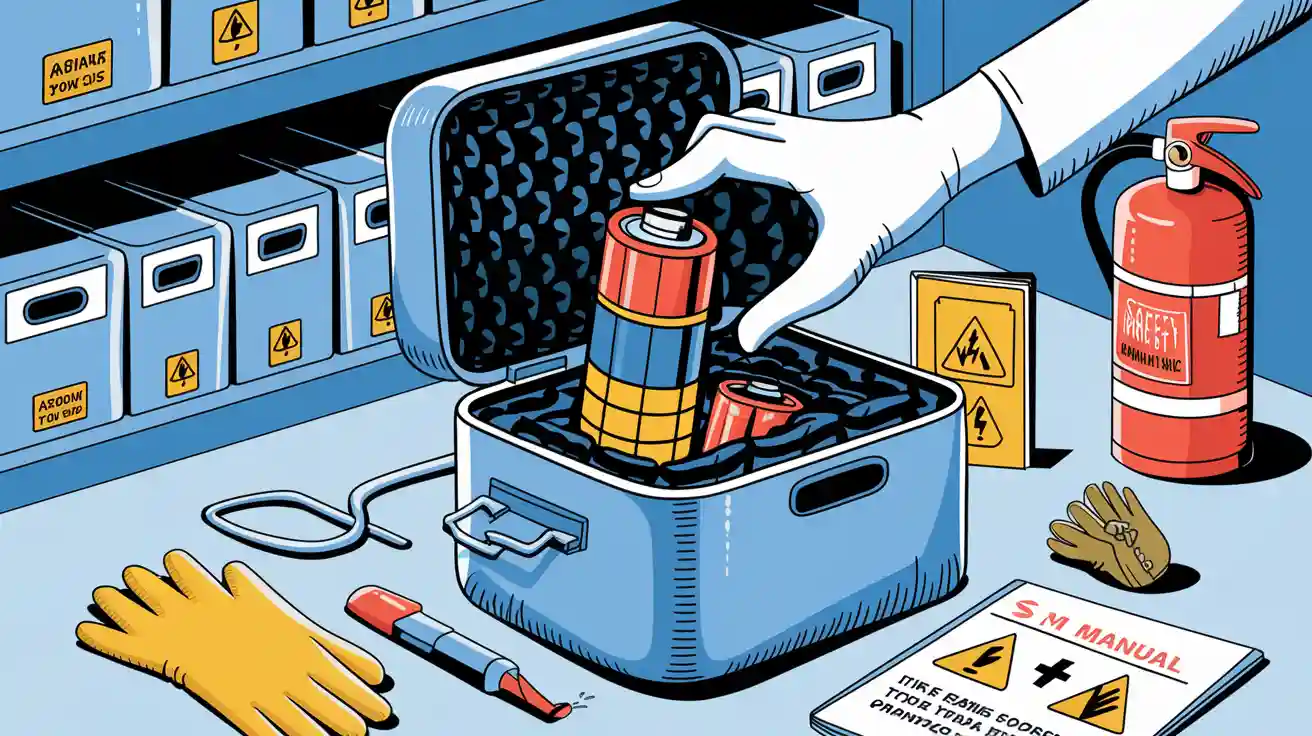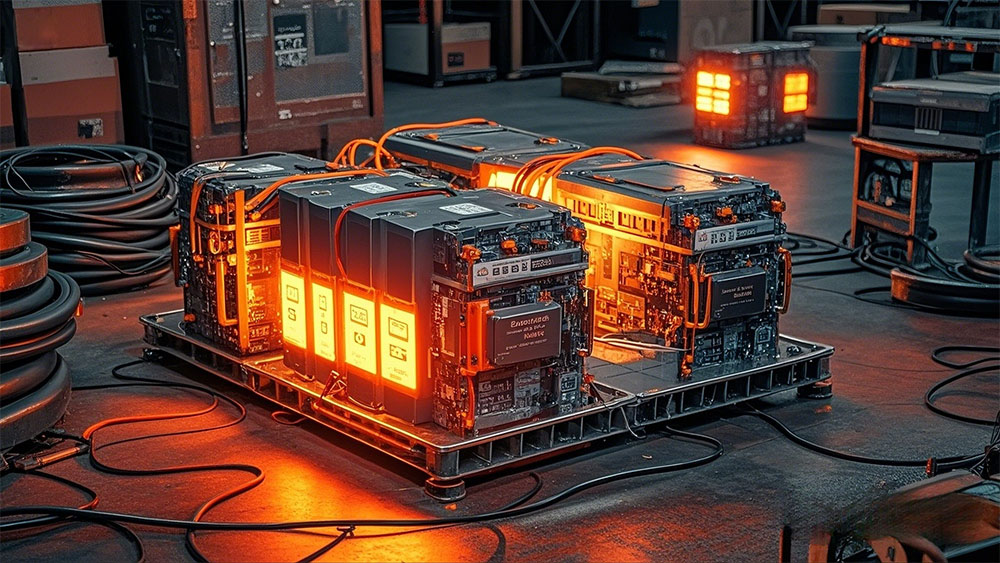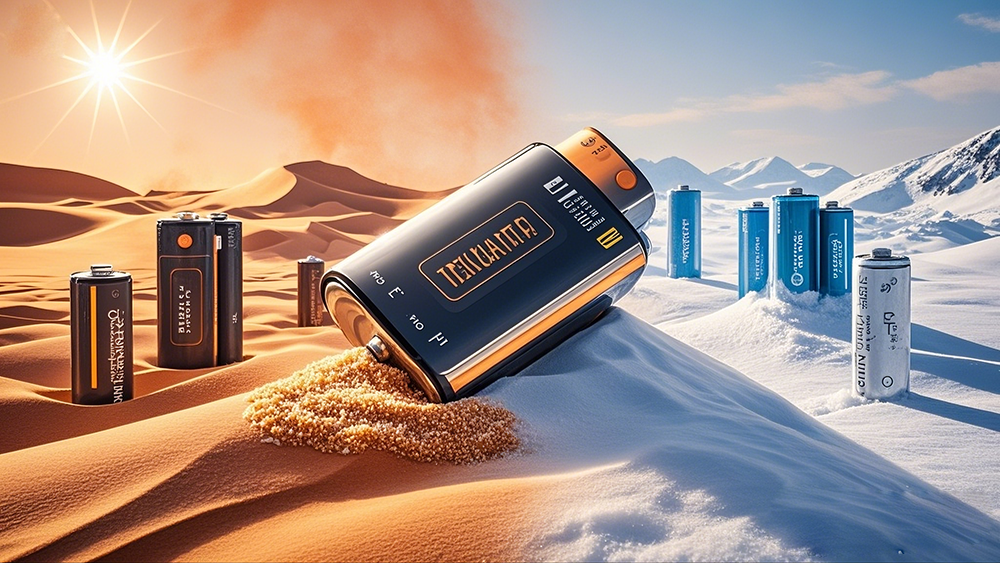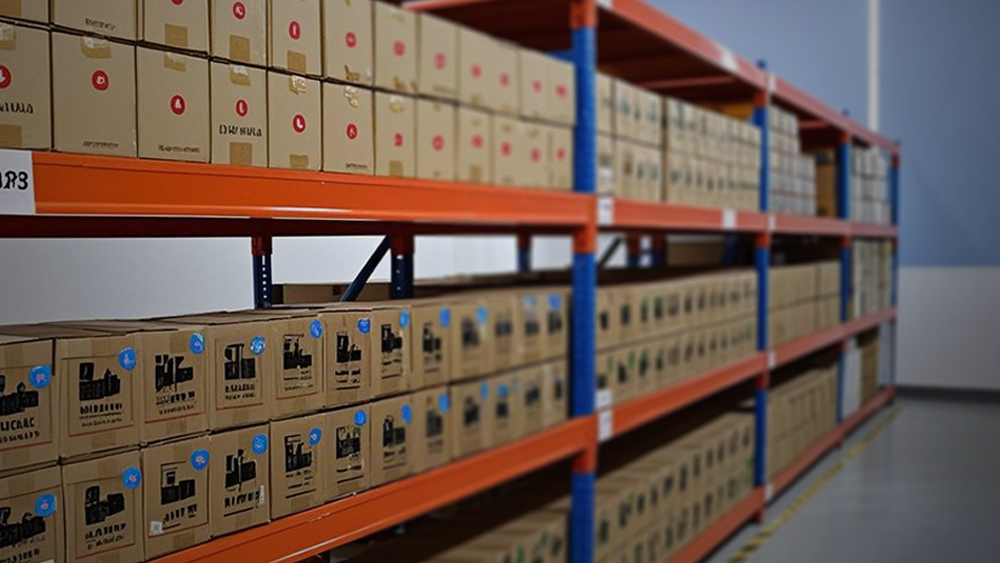Contents

Storing lithium-ion batteries correctly is essential for industrial and commercial applications. Improperly store lithium-ion batteries can lead to serious safety hazards. Studies show that 54% of businesses have faced incidents like overheating or explosions, with 19% reporting fires. Properly store lithium-ion batteries not only prevents such risks but also extends battery lifespan, making it a cost-effective choice.
Key Takeaways
- Keep lithium-ion batteries in a cool, dry spot. The temperature should stay between 15°C and 25°C. This stops overheating and helps the battery last longer.
- Store batteries with a charge level between 40% and 60%. This keeps them from wearing out and helps them work well later.
- Use safe packaging and check systems to protect batteries. This avoids damage and helps you know their condition. It also makes them safer and prevents expensive problems.

Part 1: Safety Risks of Improperly Stored Lithium-Ion Batteries
1.1 Storage Translation in High-Temperature Environment
Storing lithium-ion batteries in high-temperature environments poses significant risks. Elevated temperatures accelerate chemical reactions within the battery, increasing the likelihood of thermal runaway. This phenomenon can lead to overheating, fire, or even an explosion. Studies show that for every 10°C rise in temperature, the aging rate of a battery doubles. High temperatures also degrade the electrolyte, reducing the battery’s lifespan and performance. Efficient cooling systems and climate-controlled storage facilities are essential to mitigate these risks.
Historical incidents highlight the dangers of improper storage. For example, a factory fire in South Korea caused by a single battery cell spread to 35,000 stored cells, resulting in 22 fatalities and eight injuries. Another case involved a tractor trailer carrying lithium-ion batteries that caught fire, requiring a three-hour evacuation. These examples underscore the importance of maintaining safe storage conditions to prevent catastrophic outcomes.
1.2 Long-Term Storage in the State of Full Power (SOC >80%) or Low Battery (SOC <20%)
The state of charge (SOC) during storage significantly impacts lithium-ion battery safety. Storing batteries at full power (SOC >80%) increases the risk of electrolyte decomposition, which can release flammable gases like hydrogen and methane. On the other hand, storing batteries at a low SOC (<20%) can lead to copper corrosion, further compromising safety. Experts recommend maintaining an SOC between 40% and 60% for long-term storage. Regularly monitoring and adjusting the SOC can prevent overcharging and deep discharging, reducing the risk of thermal runaway and ensuring battery longevity.
1.3 Environmental Factors Impacting Safety (Humidity, Vibration, etc.)
Environmental factors such as humidity and vibration also affect lithium-ion battery safety. High humidity can corrode the battery casing, leading to internal short circuits. Vibrations, especially in industrial settings, can damage the electrode structure, increasing the risk of micro-short circuits. Proper storage requires maintaining a relative humidity below 60% and using protective packaging to minimize mechanical stress. Additionally, well-ventilated storage areas can prevent the accumulation of flammable gases, further enhancing safety precautions.
Tip: Always follow safety precautions and adhere to industrial guidelines, such as those set by OSHA and NFPA, to minimize risks associated with improper storage.

Part 2: How Improper Storage Affects Battery Longevity
2.1 Impact of Temperature Extremes on Battery Life
Temperature extremes significantly affect the lifespan of lithium-ion batteries. High temperatures accelerate chemical reactions inside the battery, leading to faster degradation of key components like the electrolyte and electrodes. For instance, at 55°C, the degradation rate of maximum charge storage reaches 13.24%, compared to just 4.22% at 25°C. Similarly, the resistance of the Warburg element increases by over 584% at 55°C, highlighting the severe impact of heat on battery performance.
Low temperatures, while slowing chemical reactions, can cause lithium plating on the anode. This phenomenon reduces the battery’s capacity and increases the risk of short circuits. To preserve the overall lifespan of your batteries, store them in a controlled environment with temperatures between 15°C and 25°C. Avoid exposing them to extreme heat or cold for extended periods.
2.2 Effects of Incorrect State of Charge (SOC) During Storage
The state of charge (SOC) plays a critical role in maintaining battery performance during storage. Storing lithium-ion batteries at full charge (SOC >80%) accelerates the growth of the solid electrolyte interphase (SEI) layer, reducing capacity. On the other hand, low SOC (<20%) can lead to lithium plating and copper corrosion, further degrading the battery.
For example, a study showed that a fully charged battery stored at 45°C experienced sudden failure during fast charging. In contrast, batteries stored at 80% SOC and 60°C followed different aging trajectories but retained similar capacities. To maximize longevity, maintain an SOC between 40% and 60% and monitor it periodically.
2.3 Self-Discharge and Chemical Degradation
Lithium-ion batteries naturally self-discharge at a rate of 1%-2% per month. Over time, this can lead to irreversible chemical degradation, such as the breakdown of the electrolyte and the loss of active materials in the electrodes. These processes increase internal resistance and reduce battery performance.
Storage conditions like high temperatures and incorrect SOC exacerbate these issues. For instance, degradation mechanisms such as the loss of lithium inventory (LLI) and active material in the electrodes accelerate under adverse conditions. To minimize self-discharge and chemical degradation, store batteries in a cool, dry environment and periodically recharge them to maintain an optimal SOC.

Part 3: Best Practices to Store Lithium-Ion Batteries Safely
3.1 Ideal Storage Conditions (Temperature, Humidity, and Ventilation)
To store lithium-ion batteries safely, you must maintain optimal environmental conditions. Temperature plays a critical role. The recommended range is 59°F (15°C) to 77°F (25°C). Storing batteries outside this range can lead to permanent capacity loss or even safety hazards like overheating. Avoid exposing batteries to direct sunlight, as it can cause temperature spikes.
Humidity also impacts battery safety. High humidity levels can corrode metal components, leading to internal short circuits. Keep the relative humidity below 60% to prevent such issues. Proper ventilation is equally important. A well-ventilated storage area prevents the buildup of flammable gases, reducing the risk of fires or explosions. Following these specific storage recommendations ensures both safety and battery longevity.
3.2 Managing State of Charge (SOC) for Long-Term Storage
The state of charge (SOC) is crucial for long-term storage. Storing batteries at full charge (SOC >80%) accelerates chemical degradation, while low SOC (<20%) risks copper corrosion. For optimal results, adjust the SOC to 40%-60% before storage. Periodically check and recharge the batteries to maintain this range. This practice minimizes self-discharge and prevents deep discharging, which can damage the battery. Proper SOC management ensures your batteries remain functional and safe for extended periods.
3.3 Using Protective Packaging and Monitoring Systems
Protective packaging shields lithium-ion batteries from physical damage. Use shock-resistant materials to prevent mechanical stress during storage or transportation. For industrial settings, flame-retardant storage containers add an extra layer of safety.
Monitoring systems enhance safety by providing real-time data on battery conditions. Sensors can track temperature, voltage, and gas levels, alerting you to potential risks. These systems help you take preventive action, ensuring the batteries remain in optimal condition.
3.4 Avoiding Common Storage Mistakes in Industrial Settings
In industrial environments, improper storage practices can lead to severe consequences. Avoid placing batteries near heat sources or in vehicles exposed to direct sunlight. These conditions can cause overheating. Never stack batteries without proper separators, as this increases the risk of physical damage.
Ensure that charging equipment is compatible with the batteries you store. Using incorrect equipment can lead to overcharging or short circuits. Always follow manufacturer guidelines for proper storage and charging. These steps help you avoid costly mistakes and maintain a safe storage environment.

Part 4: Future Research Directions
4.1 Material Innovations
Advancements in materials can significantly improve the safety and performance of lithium-ion batteries. One promising area is the development of high-temperature-stable electrolytes, such as ionic liquids. These electrolytes resist decomposition at elevated temperatures, reducing the risk of thermal runaway. Another breakthrough is solid-state electrolytes, which replace flammable liquid electrolytes with solid materials. Solid-state batteries offer enhanced safety by eliminating the risk of leaks and fires. They also provide higher energy density, making them ideal for long-term storage and industrial applications.
Large Power has been at the forefront of solid-state battery research. Our innovations focus on creating safer and more efficient energy storage solutions. By adopting these advanced materials, you can ensure better safety and longer battery life for your operations.
4.2 Smart Monitoring Systems
Smart monitoring systems are transforming how you manage lithium-ion batteries. These systems use sensors to track critical parameters like temperature, voltage, and gas levels in real time. Alerts notify you of potential risks, allowing you to take preventive action before issues escalate. For example, a sudden temperature spike could indicate a problem with the battery’s internal structure. Early detection helps you avoid costly failures and ensures safe storage conditions.
Integrating smart monitoring systems into your storage setup enhances safety and extends the lifespan of your batteries. These technologies are becoming essential for businesses that rely on large-scale energy storage.
4.3 Standardization
Standardization plays a crucial role in improving the safety and reliability of lithium-ion batteries. Uniform guidelines for storage, transportation, and handling ensure consistent practices across industries. For example, standardized testing methods can help you evaluate the safety of a battery under various conditions.
Adopting global standards also simplifies compliance with regulations, reducing the risk of legal issues. Organizations like the International Electrotechnical Commission (IEC) and Underwriters Laboratories (UL) are working to establish comprehensive standards. By following these guidelines, you can protect your investments and maintain operational efficiency.
Proper storage of lithium-ion batteries ensures safety, extends battery life, and optimizes costs. Mishandling can lead to fires or explosions, while correct practices prevent degradation and preserve performance. Studies highlight that maintaining optimal storage conditions enhances cost-effectiveness, with long-term benefits like improved net present value over 20 years. Businesses adopting these measures protect their investments and improve operational efficiency. Enhanced storage practices also boost performance metrics, such as achieving an 85% round-trip efficiency and maximizing energy usage.
Tip: Implementing safe storage practices not only safeguards your battery systems but also ensures sustainable and cost-effective operations.
FAQ
What is the safest way to store lithium-ion batteries for long-term use?
Store batteries in a cool, dry place with temperatures between 15°C and 25°C. Maintain a 40%-60% state of charge (SOC) and use protective packaging.
How often should you check lithium-ion batteries in storage?
Check batteries every 3-6 months. Monitor the state of charge (SOC) and recharge if it drops below 40% to prevent deep discharge and capacity loss.
Are solid-state batteries safer for long-term storage?
Yes, solid-state batteries eliminate flammable liquid electrolytes, reducing fire risks. Large Power offers advanced solid-state solutions for enhanced safety and performance.





